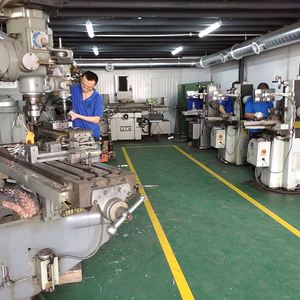
All categories
Featured selections
Trade Assurance
Buyer Central
Help Center
Get the app
Become a supplier

(3096 products available)




















The injection moulding machine involves a bunch of key components to help the working.
Feed hopper
A feed hopper is a container used for the storage of raw plastic material in the form of granular or flake. The shape and size of the feed hopper can be different based on the injection moulding machine and the plastic material used. The feed hopper is usually located in the top of the injection moulding machine. It is an entry point for plastic raw material. The design of the feed hopper is an incline or wide-open mouth, which guarantees the material can flow into the screw or ram evenly and smoothly.
Auger/screw
The function of the auger or screw is to convey the plastic raw material through the heating chamber. Then, the plastic will be melted and mixed. The screws are usually long and cylindrical. They have grooves along the surface that help move the plastic material forward. Besides, some screws have specific designs aimed at ensuring uniform melting and混合.
Heating elements
The role of the heating elements is to provide heat to melt the plastic raw materials. They are usually in bands or cartridges wrapped around the barrel. The position of the heating elements may be different along the barrel to control the temperature of the plastic precisely.
Injection moulding machines comprise multiple injection moulding machine parts, each of which is made with specific materials to fulfil a particular function.
These components have to be looked after so the injection moulding machine can work. Generally speaking, routine lubrication, cleaning, and fastener tightening by injection moulding machine manuals advice should take care of any parts. Nonetheless, the repair shop should be told if any components exhibit serious wear or need replacement to guarantee they are suitable for use with the equipment and won't compromise product quality.
The following are some common applications of plastic injection molding and how this technique has revolutionized many industries, making the mass production of quality items a walk in the park:
Injection moulding machine buyers need to evaluate the following factors before investing.
Production scale
Small production scales can do well with benchtop injection moulding machines. Those aiming for massive production volumes should get high-speed injection moulding machines. The preferred option will have a constant, large-scale injection rate.
Complexity and size of parts
High-precision injection moulding machines are ideal for making intricate parts that require exactitude. Buyers wanting large plastic parts should consider using a moulding machine with a big clamping force. The force will help it produce sizeable parts without breaking or deforming them.
Materials used
Consider the types of materials the injection moulding machine will use. Certain materials need specific features for ideal performance. Some have strong melting temperatures and need powerful heaters and higher barrel speeds to achieve uniform melting. Others are flexible and need a gentle approach to avoid damage during processing.
Automation and control
Machines with advanced automated systems can lower costs by minimizing manual input and boosting production speed. However, the advantage might diminish in systems that require regular tool changes due to varied production needs. Also, consider whether the operator will need advanced training to operate the injection moulding machine. Consider opting for a simple injection moulding machine with a user-friendly interface to minimize training needs.
Maintenance and service support
Before buying, know the injection moulding machine's maintenance requirements. Also, investigate the supplier's service record. In some cases, it might be better to choose a moulding machine that requires regular but quick maintenance over one that needs infrequent but lengthy maintenance.
Q1: How long does it take to produce injection moulding machine components?
A1: Lead times may vary depending on the size and complexity of the injection moulding machine components, as well as the availability of materials and the schedule of the manufacturing facility. Generally, it can take anywhere between 2 weeks to 6 weeks to produce injection moulding machine components.
Q2: What injection parts are commonly used?
A2: Some of the most trending injection moulding parts are pipe fittings, containers, automotive parts, toys, brackets, tool handles, combs, telephone parts, etc.
Q3: What are the major components of the injection moulding process?
A3: The injection moulding process includes the injection unit, clamping unit, control system, cooling system, power system, ejector system, nozzle, and screw.